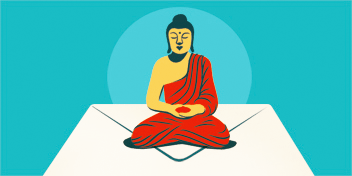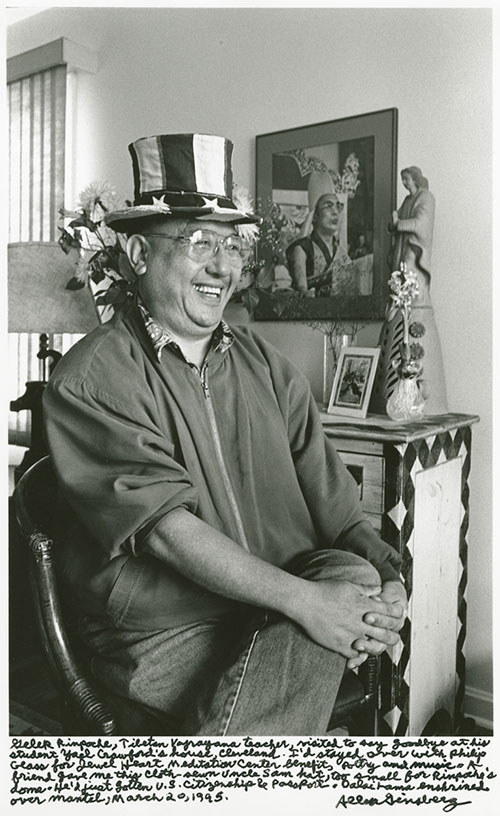A year and a half into mask-wearing and social isolation, the new Allen Ginsberg photography exhibit at the Tibet House, Transforming Minds: Kyabje Gelek Rimpoche and Friends, is a welcome reminder of the power of friendship and human connection. Immediately disarming and full of emotion, the forty black-and-white photos, some of them never seen before, also remind viewers of the personal side of Tibetan Buddhism—that even a Buddhist lama considered to be one of the great teachers of our time and one of the last lamas to be educated in Tibet before the Chinese takeover relaxes around the kitchen table, lies out on the lawn, and laughs with friends.
Ginsberg, best remembered for his poetry, was also a photographer who actively captured his peers and friendships with the likes of Jack Kerouac and William S. Burroughs. But he didn’t photograph any of his teachers in the same way that he did Gelek Rimpoche. The pair met at a benefit concert for the Jewel Heart Tibetan Buddhist Learning Center in 1989 after Philip Glass, a student of Rimpoche’s at the time, invited Ginsberg to perform. Rimpoche, who fled Tibet in 1959 and moved to the United States in the 1980s, had founded the Michigan location of Jewel Heart the previous year. From the time they were introduced until 1997, when Ginsberg passed away, Ginsberg took hundreds of photos of Rimpoche and their mutual friends, among them Glass, Chairman of Tibet House US and of Jewel Heart (and a Tricycle Board member), and Robert Thurman, founder of Tibet House US.
Given all these shared connections, when the Allen Ginsberg Estate and Jewel Heart were considering a home for a collection of Ginsberg’s photos portraying Rimpoche, Tibet House was an obvious choice. As Tibet House Managing Director Beata Tikos, says, “It made all the sense in the world. You immediately understand this isn’t a show about one relationship, but about a matrix of people.”
The pandemic delayed the show, but it also gave curators Peter Hale and Ben Paljor Chatag extra time to explore the some 500 negatives that had recently been digitized and narrow down what would end up on display. One look at the exhibit and it makes sense that both curators personally knew subject and photographer. Hale, the photo archivist at the Allen Ginsberg Estate, worked with Ginsberg for five years before the poet-photographer passed away. Chatag, a multimedia artist, is Rimpoche’s grandson and played a crucial role in identifying many of the Tibetan lamas featured in the photos.
One of Chatag’s favorite photos from the show depicts his grandfather on the day that he became a U.S. citizen, laughing and wearing an Uncle Sam hat, with a photo of the Dalai Lama in the background.
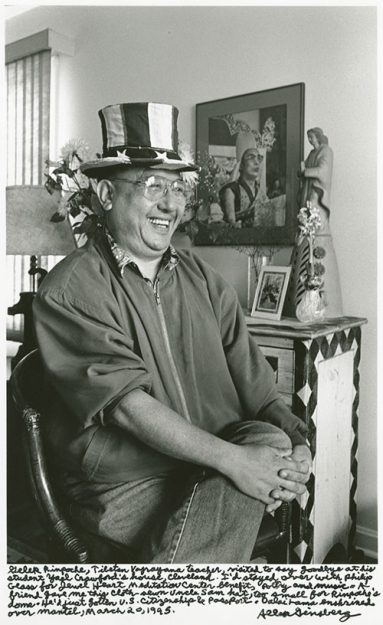
The caption, written by Ginsberg, reads: “Gelek Rimpoche, Tibetan Vajrayana teacher, visited to say goodbye at his student Yael Crawford’s house, Cleveland. I’d stayed over with Philip Glass for Jewel Heart Meditation Center benefits poetry and music. A friend gave me this cloth-sewn Uncle Sam hat, too small for Rimpoche’s dome. He’d just gotten U.S. citizenship & passport. Dalai Lama enshrined over mantel, March 20, 1995.”
Hale loves a photo of Rimpoche in a suit and tie, standing on First Avenue at Thirteenth Street with the bus driving by.
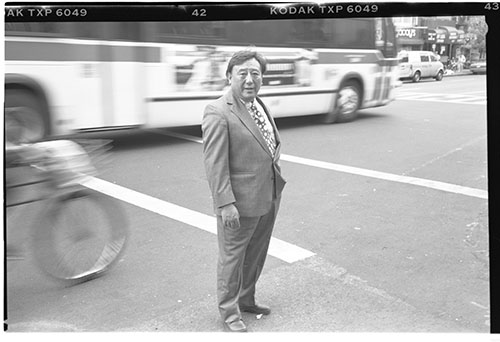
A loop of four videos showing scenes of Rimpoche and moments captured in the series plays on one wall of the exhibit. In one video, Patti Smith recounts her first encounter with Tibet as a child to the audience of the Jewel Heart benefit concert in 1995—a funny and poignant memory reflected in one of the stills on the wall.
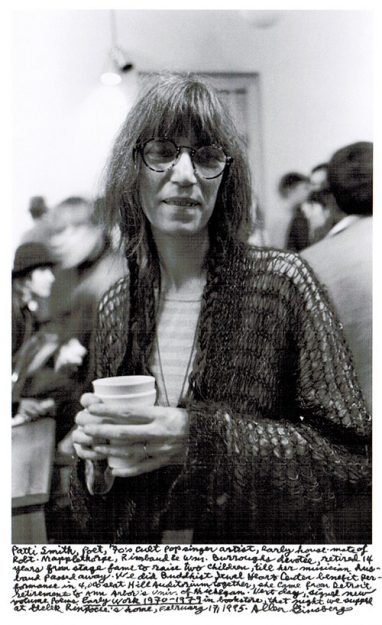
Ginsberg’s caption reads: “Patti Smith, poet, 70’s cult pop singer artist, early house-mate of Robt. Mapplethorpe, Rimbaud & Wm Burroughs devotee, retired 14 years from stage fame to raise two children, till her musician husband passed away. We did Buddhist Jewel Heart Center benefit performance in 4000 seat Hill Auditorium together, she came from Detroit retirement to Ann Arbor Univ of Michigan. Next day, Signed & Stamped new volume poems Early Work 1970-1979 in bookstore that night we supped at Gelek Rimpoche’s home, February 17, 1995.”
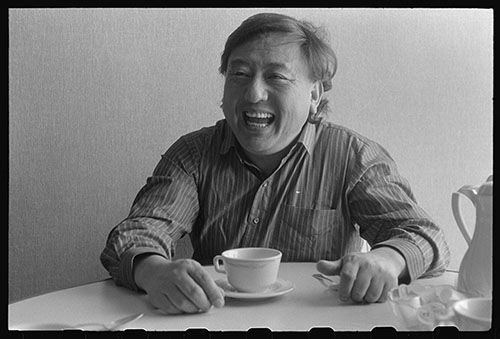
It’s easy to be taken by the photo of Rinpoche laughing with a cup of coffee at a Jewel Heart board meeting, or by one of the many when he’s smiling wide or relaxing in Ginsberg’s kitchen.
It’s also easy to imagine the close bonds among the subjects, as in a photo of Ginsberg, Glass, Rimpoche, and Thurman at a Jewel Heart Summer Retreat.
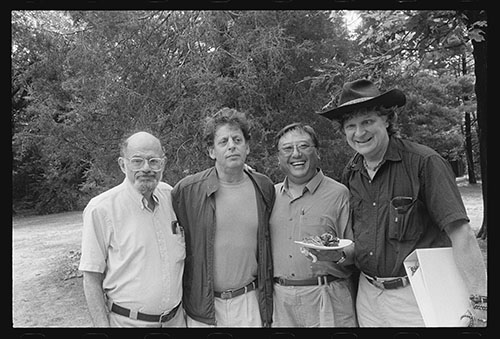
Hale recalls Ginsberg saying, “I’m not a documentarian,” but that instead, his photographs were tributes to his friends, or gestures of appreciation. In the case of Transforming Minds, that appreciation is plain to see and shared by many.
Thank you for subscribing to Tricycle! As a nonprofit, we depend on readers like you to keep Buddhist teachings and practices widely available.
